
Eudonia philerga is a species of moth of the family Crambidae. This species was first described by Edward Meyrick. It is endemic to New Zealand, found throughout the country, and regarded as common. Larvae feed on moss. Adult moths have been observed on the wing more frequently from October to April, and are attracted to light.

Heterocrossa adreptella is a moth of the Carposinidae family. This species was long considered the New Zealand raspberry budmoth however this was a taxonomic misinterpretation of the type material used to describe this species. This error was corrected in 1988 with the New Zealand raspberry budmoth giving its own species name Heterocrossa rubophaga. H. adreptella is endemic to New Zealand and has been collected in the Wellington Botanic Garden and been observed resting on mānuka branches.
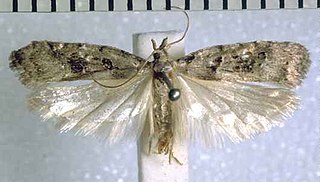
Heterocrossa canescens is a species of moth in the family Carposinidae. It is endemic to New Zealand. This species has been observed in Aoraki / Mount Cook National Park and in the Southern Alps. The larvae of this species feed on the fruits and flowers of endemic to New Zealand species in the genus Gaultheria. Adult moths are on the wing in November and from January to March.

Heterocrossa ignobilis is a species of moth in the family Carposinidae. It was described by Alfred Philpott and is endemic to New Zealand and has been observed in Canterbury, in the South Island. Adults are on the wing in January.

Heterocrossa contactella is a species of moth in the family Carposinidae. It is endemic to New Zealand and can be observed in both the North and South Islands. The preferred habitat of this species is native forest and scrub, especially where Leptospermum shrubs are found. Adults are on the wing in December and January.
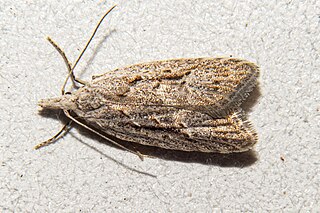
Heterocrossa cryodana is a species of moth in the family Carposinidae. It is endemic to New Zealand and is found in the southern parts of the South Island as well as at Codfish Island / Whenua Hou. This moth is associated with plants in the Leptospermum genus. Adults are on the wing from September until January.
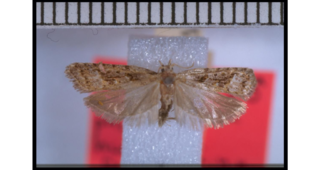
Heterocrossa philpotti is a species of moth of the family Carposinidae. It is endemic to New Zealand. It currently has two subspecies, although it has been hypothesised that Hetercrossa philpotti hudsoni may have two different species confused within this subspecies name.

Heterocrossa epomiana is a species moth in the family Carposinidae. It is endemic to New Zealand and has been observed in Westland. Adults are on the wing in January. This species is visually very similar to H. gonosemana and to H. philpotti.

Heterocrossa eriphylla, also known as the lichen snoutlet moth, is a species of moth in the family Carposinidae. It is endemic to New Zealand and is found in the North Island and the northern parts of the South Island. This species is regarded as relatively uncommon and inhabits native forest. The larvae feed on the healing wounds of New Zealand beech trees Fuscospora fusca and Fuscospora truncata. It pupates at its feeding site and emerges from December onward. The adult moth is nocturnal and is attracted to light. During the day the moth rests on lichen covered tree trunks where their lichen mimicking colouration assists with their camouflage.

Heterocrossa exochana is a species of moth in the family Carposinidae. It is endemic to New Zealand and has been observed in the North and South Islands. The larvae of this species feed on the fruits of Muehlenbeckia species. The adult is on the wing from September until May and are attracted to light.

Heterocrossa gonosemana is a species of moth in the family Carposinidae. It is endemic to New Zealand and is found throughout the country. It inhabits native forest. Larvae feed on seeds and fruit of Griselinia lucida and possibly Griselinia littoralis. They can be extremely active when disturbed. This species overwinters as a pupa, enclosed in a cocoon, underneath its host plant. Adults are on the wing from November until February and can be found during the day resting on lichen covered tree trunks where they are well camouflaged. The adult is nocturnal and is attracted to light.

Heterocrossa literata is a moth of the Carposinidae family first described by Alfred Philpott in 1930. It is endemic to New Zealand and has been observed the Franz Josef Glacier in subalpine habitat on the West Coast. Adults are on the wing in January.
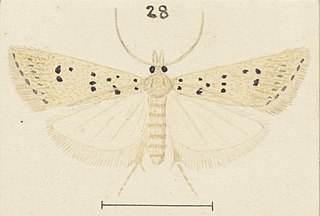
Heterocrossa maculosa is a species of moth in the family Carposinidae. It is endemic to New Zealand and has been found in the southern half of the South Island. Larvae feed on Hoheria angustifolia and Plagianthus regius. Adults are on the wing from November to January. This species is classified as "Data Deficient" by the Department of Conservation.

Heterocrossa morbida is a moth of the Carposinidae family. It was described by Edward Meyrick in 1912 and is endemic to New Zealand. This species has been observed in both the North and South Islands. Adults are on the wing from August until February and are said to frequent clumps of Hoheria lyallii.

Heterocrossa sanctimonea is a moth of the Carposinidae family first described by Charles E. Clarke in 1926. It is endemic to New Zealand.

Heterocrossa sarcanthes is a moth of the Carposinidae family first described by Edward Meyrick in 1918. It is endemic to New Zealand and has been observed in Wellington. The adults of this species is similar in appearance to H. adreptella but can be distinguished from that species as H. sarcanthes has a pale pinkish-ochreous colour to the basal half of the hindwings.

Heterocrossa is a genus of moths in the Carposinidae family. It is endemic to New Zealand. This genus was previously regarded as a synonym of the genus Carposina. However Elwood C. Zimmerman in Insects of Hawaii removed Heterocrossa from synonymy with Carposina. Zimmerman argued that as the genitalia of Heterocrossa and Carposina are distinct, Heterocrossa should not be regarded as a synonym of Carposina. This was agreed with by John S. Dugdale in his annotated catalogue of New Zealand Lepidoptera.
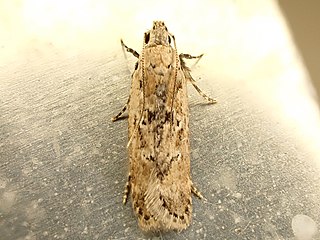
Anisoplaca achyrota is a species of moth in the family Gelechiidae. It was first described by Edward Meyrick in 1885 and is endemic to New Zealand. This species has been observed in both the North and South Islands and inhabits native forest. The larvae of this species feed on the green seeds of Hoheria angustifolia and as such is regarded as an indicator species for mature native forest. The adults of the species are commonly on the wing from December until February and are attracted to light.
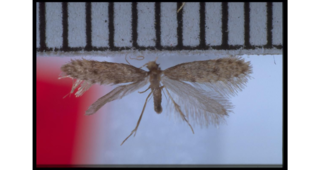
Grypotheca pertinax is a moth of the Psychidae family first described by John S. Dugdale in 1987. It is endemic to New Zealand.
Charles Edwin Clarke was a New Zealand dentist and amateur entomologist, who specialised in collecting lepidoptera and coleoptera.


















